Calculation Method of Rotational Constraint Stiffness for a New Tower-Pier Connected System
Abstract
:1. Introduction
2. The Plane Rotation Model of UHS
- (1)
- The pressure on the contact surface is evenly distributed along the surface.
- (2)
- Both the top plate and the bottom basin are rigid bodies.
3. RCS Calculation Model of UHS
3.1. Finite Element Model of UHS
- Material parameters
- 2.
- Mesh partition
- 3.
- Boundary conditions and loads
- 4.
- Definition of interaction
3.2. Parametric Analysis of RCS
3.2.1. Influence of Vertical Force on RCS
- Critical torque analysis
- 2.
- FE-based RCS Analysis
3.2.2. Influence of Central Angle on RCS
3.2.3. Influence of Curvature Radius of Contact Surface on RCS
3.2.4. Influence of Friction Coefficient of Contact Surface on RCS
3.3. RCS Calculation Model of UHS
4. Calculation Procedure of Mechanical Properties of Cable-Stayed Bridge with UHS
5. Case Study: An Inclined Single-Tower Cable-Stayed Bridge
5.1. Bridge Overview
5.2. Finite Element Model of the Cable-Stayed Bridge
5.3. Calculation of RCS at Each Construction Stage
5.4. Verification of RCS Calculation Model Based on Monitoring Data
6. Discussion
7. Conclusions
Author Contributions
Funding
Institutional Review Board Statement
Informed Consent Statement
Data Availability Statement
Acknowledgments
Conflicts of Interest
Nomenclature
| STCSB | single-tower cable-stayed bridge |
| UHS | universal hinge support |
| RCS | rotational constraint stiffness |
| FE | finite element |
| F | vertical force transferred from tower to UHS |
| M | reaction torque |
| MR | critical torque |
| R0 | spherical radius of UHS |
| R1 | radius of the vertical projection surface of the arc-contact surface |
| R2 | radius of the arc-contact surface |
| θ | central angle |
| q0 | uniform distributed force at the top plate |
| q | uniform distributed force at the bottom basin |
| qv | vertical component force of q |
| qt | tangential component force of q in the arc surface |
| f | friction force |
| r | radius of the micro-ring |
| ds | area of the micro-ring |
| μ | friction coefficient |
| k | slope of the load-displacement curve |
| KM | rotational constraint stiffness of the UHS |
| α | a coefficient with dimensions (m/rad) |
| β | a coefficient with dimensions (kN/rad) |
| γ | a coefficient with dimensions (kN·m/rad) |
| ξ | a dimensionless coefficient |
References
- Podolny, W.; Scalzi, J.B. Construction and Design of Cable-Stayed Bridges, 2nd ed.; Wiley: New York, NY, USA, 1986. [Google Scholar]
- Troitsky, M.S. Cable-Stayed Bridges: Theory and Design; Crosby Lockwood Staples: London, UK, 1977. [Google Scholar]
- Shilin, L.; Liang, Z.; Meng, F. Cable Stayed Bridge; China Communications Press: Beijing, China, 2002. (In Chinese) [Google Scholar]
- Watson, C.; Watson, T.; Coleman, R. Structural Monitoring of Cable-Stayed Bridge: Analysis of GPS versus Modeled Deflections. J. Surv. Eng. 2007, 133, 23–28. [Google Scholar] [CrossRef]
- Guest, J.K.; Draper, P.; Billington, D.P. Santiago Calatrava’s Alamillo Bridge and the Idea of the Structural Engineer as Artist. J. Bridge Eng. 2013, 18, 936–945. [Google Scholar] [CrossRef]
- Aparicio, A.C.; Casas, J.R.; Calatrava, S. The Alamillo Cable-Stayed Bridge: Special Issues Faced in The Analysis and Construction. Proceedings of the Institution of Civil Engineers. Struct. Build. 1997, 122, 432–450. [Google Scholar] [CrossRef]
- Casas, J.R.; Aparicio, A.C. Monitoring of The Alamillo Cable-Stayed Bridge During Construction. Exp. Mech. 1998, 38, 24–28. [Google Scholar] [CrossRef]
- Fernandez Troyano, L.; Manterola Armisen, J. Bridge over the River Lerez, In Pontevedra. Reflection on The Waters. Cauce 1995, 2000, 60–67. [Google Scholar]
- Liu, Y.-J.; Zhou, X.-H.; Yan, D.-H.; Geng, J. Stress analysis of tower-beam joint of inclined tower cable-stayed bridge with steel-concrete girder. China J. Highway Transp. 2003, 66–70. [Google Scholar] [CrossRef]
- Troyano, L.F.; Armisén, J.M.; Suárez, M.A.A. The Inclined Towers of the Ebro and Lérez Bridges. Struct. Eng. Int. 1998, 8, 258–260. [Google Scholar] [CrossRef]
- Chvojková, P.N.; Fošumpaur, P.; Hladík, M.; Horský, M.; Kašpar, T.; Králík, M.; Zukal, M. Historical and Modern Bridges over the Elbe-Vltava Waterway. In IOP Conference Series: Materials Science and Engineering; IOP Publishing: Bristol, UK, 2021; Volume 1203, p. 022014. [Google Scholar]
- Zhang, Y.; Wang, X.; Liu, Y.; Li, R. Study on Boundary Conditions of Ground Anchored Cable Stayed Bridge with Single Inclined Tower. In IOP Conference Series: Earth and Environmental Science; IOP Publishing: Bristol, UK, 2021; Volume 647, p. 012026. [Google Scholar]
- Martins, A.M.; Simões, L.M.; Negrão, J.H. Optimization of cable-stayed bridges: A literature survey. Adv. Eng. Softw. 2020, 149, 102829. [Google Scholar] [CrossRef]
- Yan, Y.-H.; Sun, Y.-G.; He, L.-Z. Construction Control of New Tuanbo Bridge in Tianjin. Bridge Constr. 2013, 43, 99–103. (In Chinese) [Google Scholar]
- Wang, S. Study on Cable Tension Method of Spatial Cable Plane. Munic. Technol. 2016, 34, 53–56. (In Chinese) [Google Scholar]
- Song, J. Construction technology of color needle steel single tower for long span cable-stayed bridge. Natl. Def. Transp. Eng. Technol. 2019, 17, 36–39+30. (In Chinese) [Google Scholar]
- Hou, M.; Zhang, Z.-Q.; Fan, Z.-W. Overall Design of Haitang Bay Cable-Stayed Pedestrian Bridge in Sanya. World Bridges 2021, 49, 1–6. (In Chinese) [Google Scholar]
- Zhou, Y.; Tian, R.; Wu, L.; Zhao, Y. Mechanical characteristics analysis of pylon-hinged single-pylon cable-stayed bridge during construction. Sci. Technol. Eng. 2020, 20, 8785–8790. (In Chinese) [Google Scholar]
- Amer, T.S.; Galal, A.A.; Abady, I.M.; Elkafly, H.F. The dynamical motion of a gyrostat for the irrational frequency case. Appl. Math. Model. 2021, 89, 1235–1267. [Google Scholar] [CrossRef]
- Amer, W.S. Modelling and analyzing the rotatory motion of a symmetric gyrostat subjected to a Newtonian and magnetic fields. Results Phys. 2021, 24, 104102. [Google Scholar] [CrossRef]
- Li, J.Z.; Peng, T.B.; Xu, Y. Damage investigation of gird-er bridges under Wenchuan Earthquake and corresponding seismic design recommendations. Earthq. Eng. Eng. Vib. 2008, 7, 337–344. [Google Scholar] [CrossRef]
- Itoh, Y.; Yazawa, A.; Kitagawa, T.; Kainuma, S.; Yamamoto, Y.; Kutsuna, Y. Study on environmental durability of rubber bearing for bridges. In IABSE Symposium Report International Association for Bridge and Structural Engineering; Currant Associates Inc.: New York, NY, USA, 2002. [Google Scholar]
- Gu, H.S.; Itoh, Y. Ageing behaviors of natural rubber and high damping rubber materials used in bridge Rubber bearings. Adv. Struct. Eng. 2010, 6, 1105–1113. [Google Scholar] [CrossRef]
- Itoh, Y.; Gu, H.; Satoh, K.; Kutsuna, Y. Experimental investigation on ageing behaviors of rubbers used for bridge bearings. Struct. Eng./Earthq. Eng. 2006, 62, 17–31. [Google Scholar] [CrossRef] [Green Version]
- Fogato, M. The role of boundary conditions in the torsional instability of suspension bridges. J. Math. Anal. Appl. 2023, 518, 126729. [Google Scholar] [CrossRef]
- Adema, A.; María, H.S.; Guindos, P. Analysis of instant and long-term performance of timber-concrete floors with boundary conditions other than simply supported. Eng. Struct. 2022, 254, 113827. [Google Scholar] [CrossRef]
- Han, Q.; Zhang, Y.-G.; Zhao, K.-H. A Numerical Method of the Contact Problems in Structural Engineering. J. Beijing Univ. Technol. 2006, 4, 321–326. (In Chinese) [Google Scholar]
- Guo, X.-M.; Zhao, H.-L. Study on contact problems in engineering structures. J. Southeast Univ. (Nat. Sci. Ed.) 2003, 5, 577–582. (In Chinese) [Google Scholar]
- Fang, X.; Zhang, C.; Chen, X.; Wang, Y.; Tan, Y. A new universal approximate model for conformal contact and non-conformal contact of spherical surfaces. Acta Mech. 2014, 226, 1657–1672. [Google Scholar] [CrossRef]
- Li, Z.X.; Zhou, T.Q.; Chan, T.H.T.; Yu, Y. Multi-scale numerical analysis on dynamic response and local damage in long-span bridges. Eng. Struct. 2007, 29, 1507–1524. [Google Scholar] [CrossRef]
- Zhou, M.; Ning, X.; Nie, J. 4-D multiscale finite element analysis of the hybrid zone for cable-stayed bridges with steel-concrete hybrid girders. J. Tsinghua Univ. (Sci. Technol.) 2014, 54, 1321–1326. [Google Scholar]
- Wang, Y.; Li, Z.; Wang, C.; Wang, H. Concurrent multi-scale modelling and updating of long-span bridges using a multi-objective optimisation technique. Struct. Infrastruct. Eng. 2013, 9, 1251–1266. [Google Scholar] [CrossRef]
- Xiao, X.; Yan, Y.; He, J.; Chen, B. Multi-scale finite element modeling and model updating of long span cable-stayed bridge. J. Huazhong Univ. Sci. Technol. (Nat. Sci. Ed.) 2017, 45, 121–127. [Google Scholar]
- Zheng, L.; Wang, W.-D. Multi-scale numerical simulation analysis of CFST column-composite beam frame under a column-loss scenario. J. Constr. Steel Res. 2022, 190, 107151. [Google Scholar] [CrossRef]
- Wang, W.; Li, H.; Wang, J. Progressive Collapse Analysis of Concrete-filled Steel Tubular Column to Steel Beam Connections Using Multi-scale Model. Structures 2016, 9, 123–133. [Google Scholar] [CrossRef]
- Salehi, M.; Erduran, E. Identification of boundary conditions of railway bridges using artificial neural networks. J. Civ. Struct. Heal. Monit. 2022, 12, 1223–1246. [Google Scholar] [CrossRef]
- Li, B.; Wang, S.-H.; Yan, Q.-M. Rotational Performance and Structural Analysis of Spherical Bearing Based on ABAQUS Nonlinear Contact Analysis. Railw. Eng. 2012, 11, 10–13. (In Chinese) [Google Scholar]
- Peng, T.-B.; Shi, X.-F. Theoretical Study of a Simplified Formula for Rotating Torque of Spherical Bearings. Bridge Constr. 2014, 44, 92–97. (In Chinese) [Google Scholar]
- Yang, F. Analysis of Basic Mechanical Performances Test Results for Spherical Bearings of Railway Bridge. Railw. Eng. 2021, 61, 23–26. (In Chinese) [Google Scholar]
- Shi, K.-R.; Pan, W.-Z.; Jiang, Z.-R.; Lü, J.-F.; Luo, B. Mechanical Behaviors of Large-tonnage Complex Steel Spherical Hinged Support: Rotation Behavior Subjected to Axial Compressive Load. J. South China Univ. Technol. (Nat. Sci. Ed.) 2019, 47, 9–15. (In Chinese) [Google Scholar]




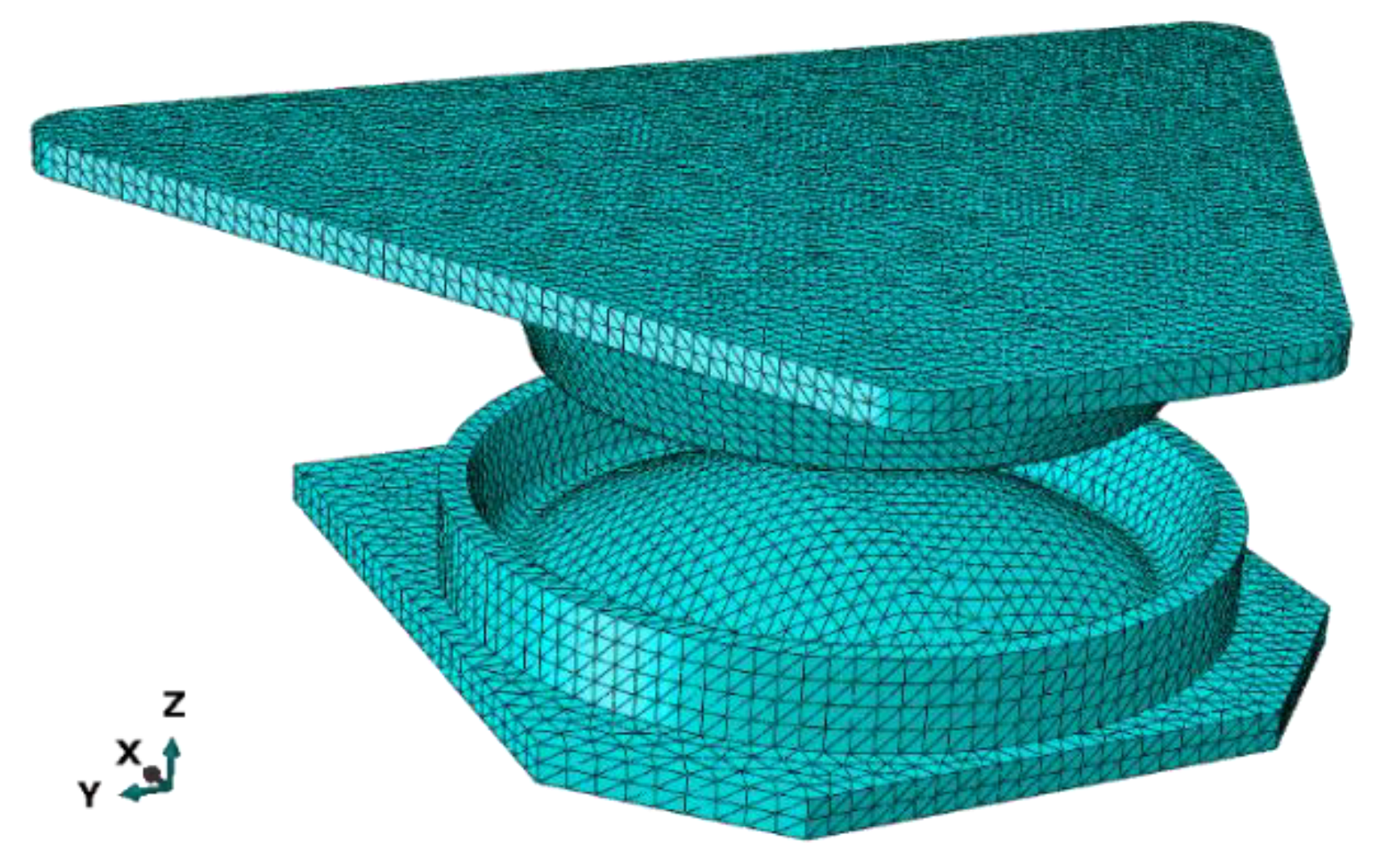
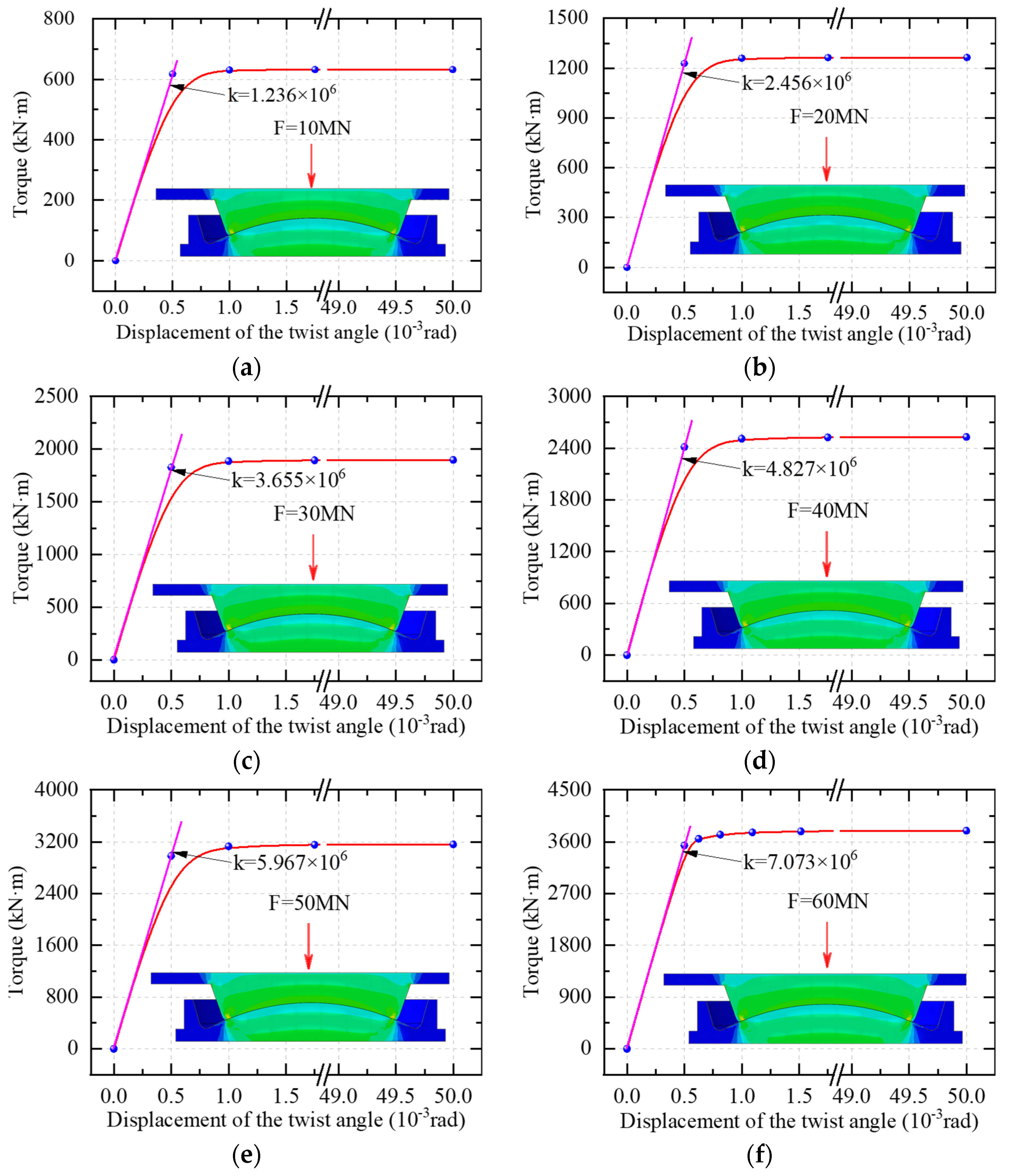

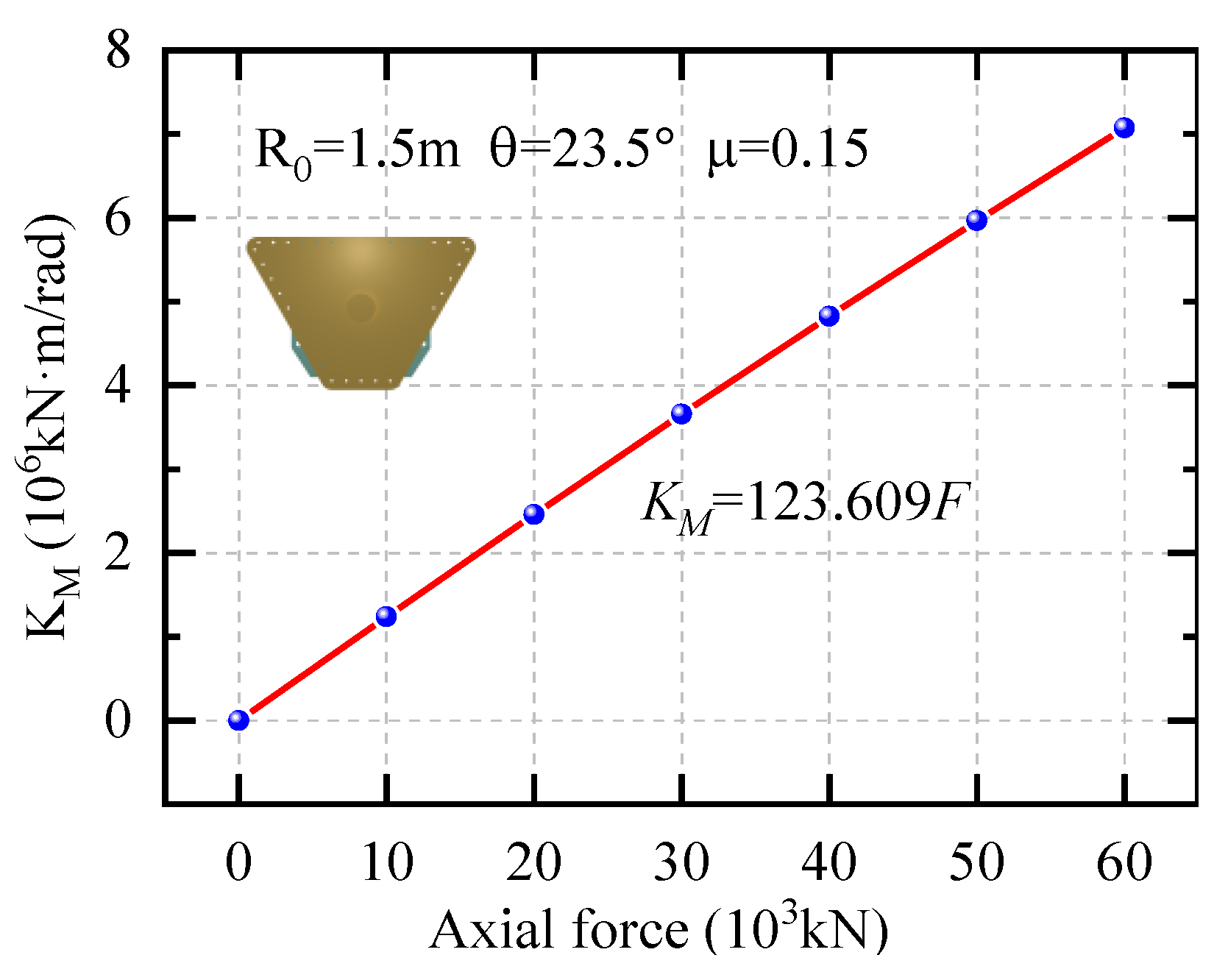
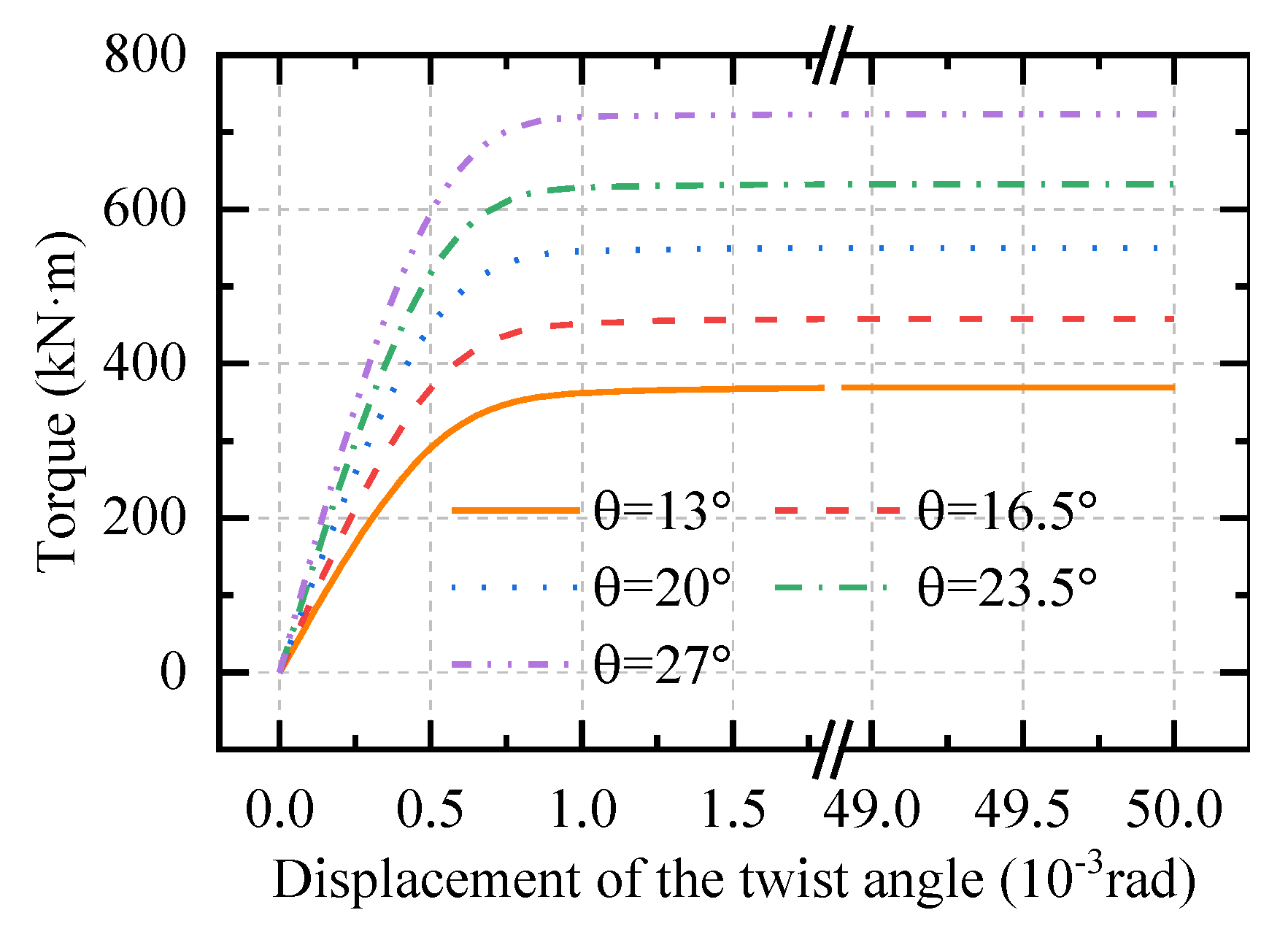

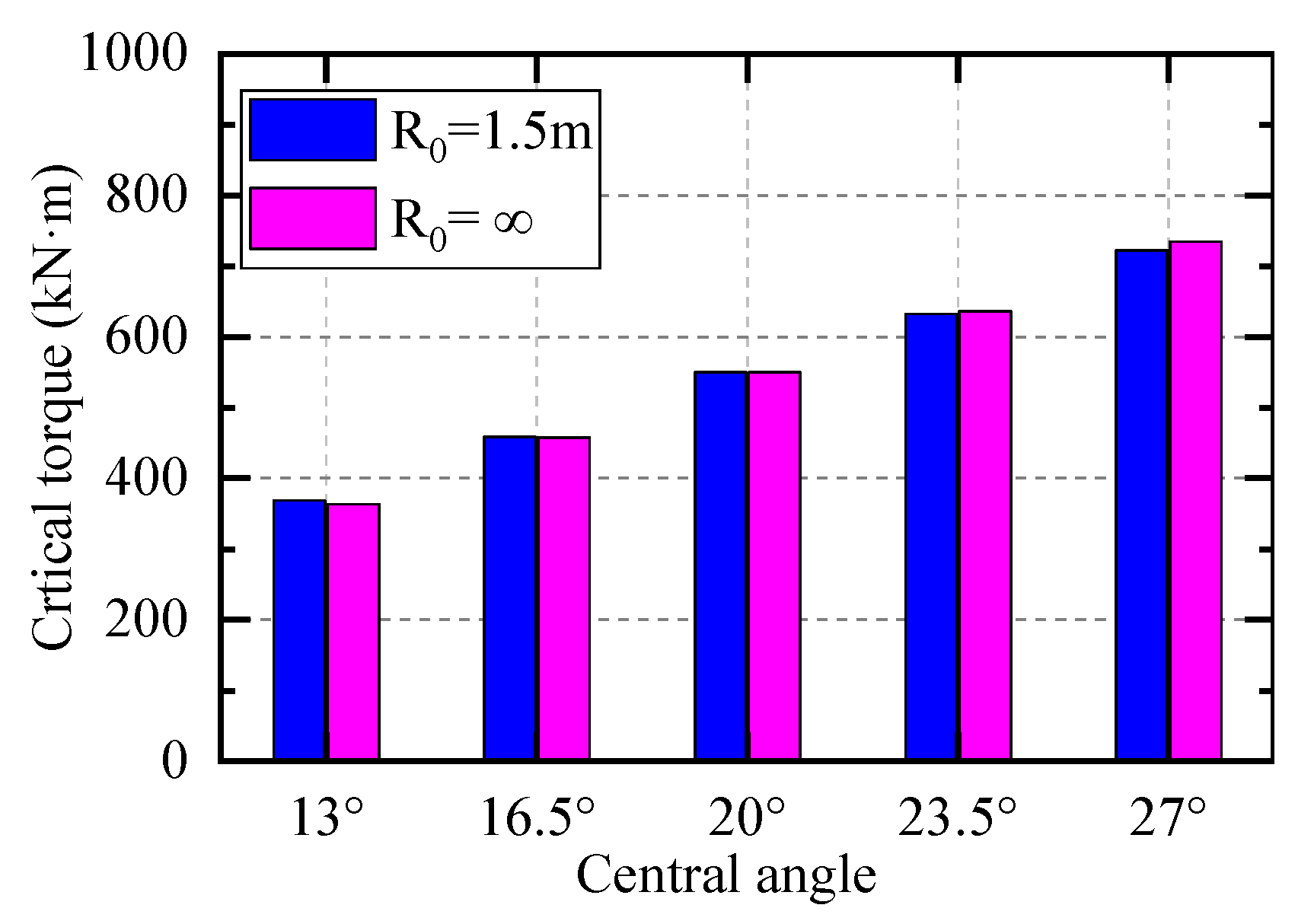



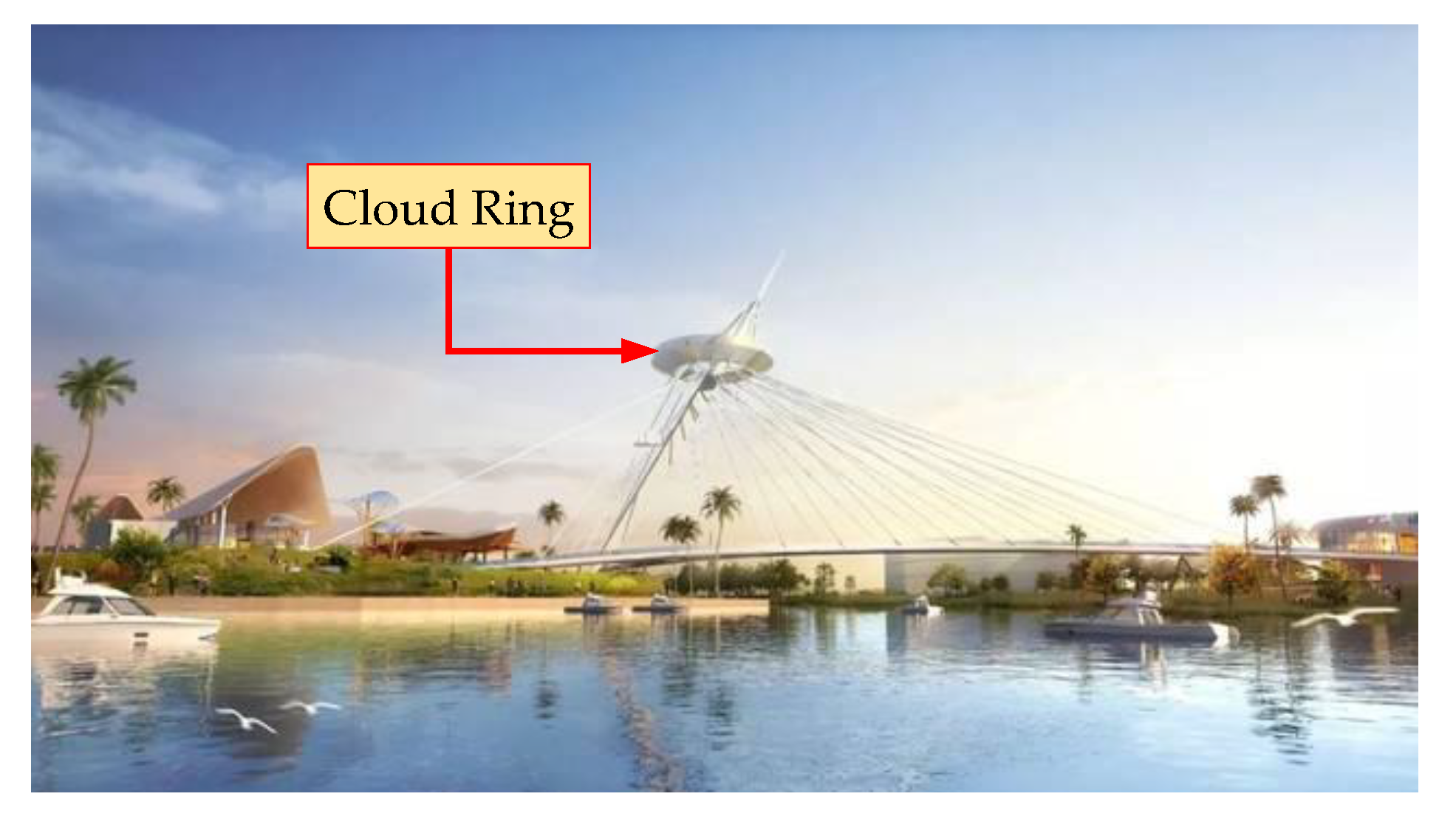
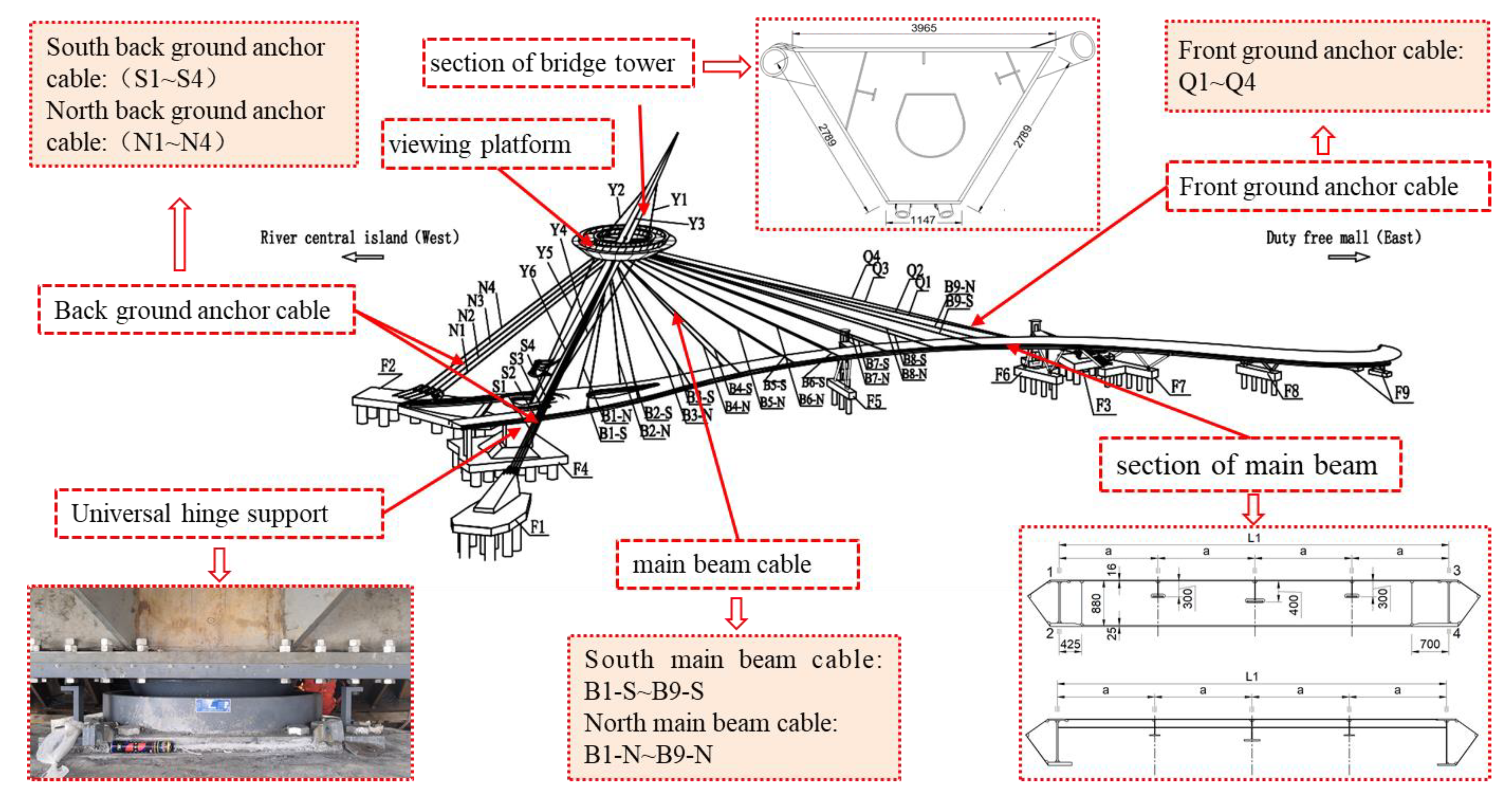


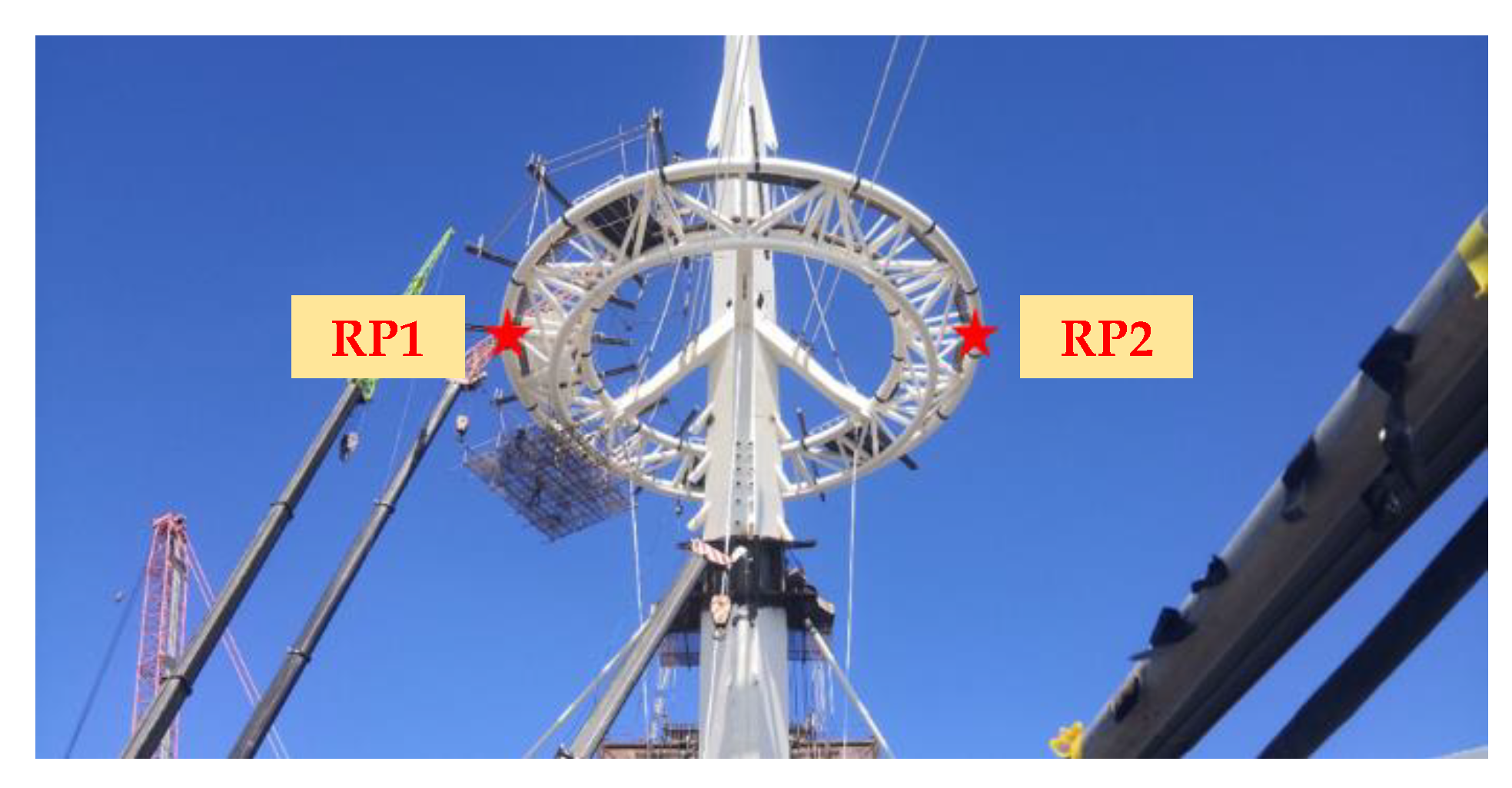

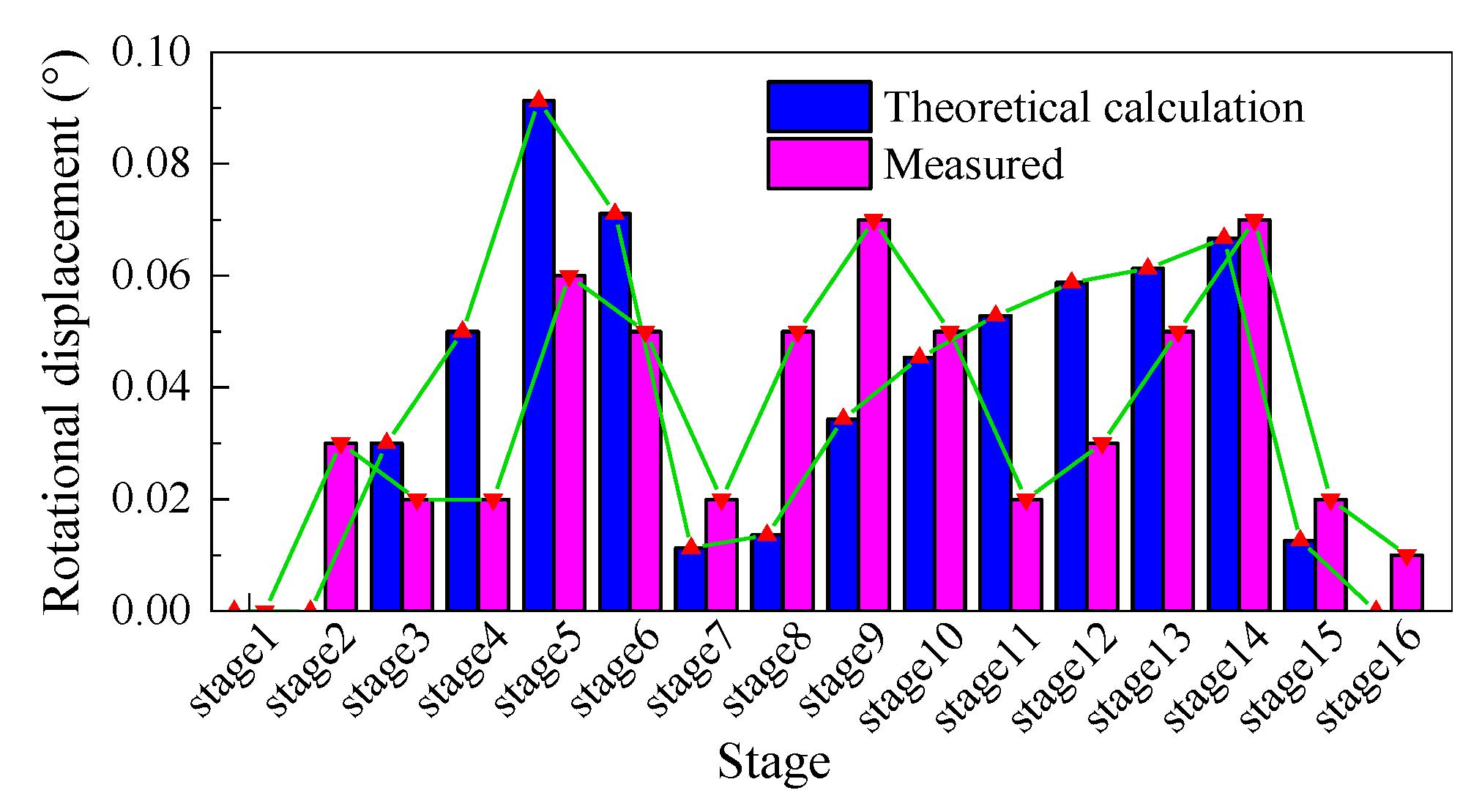
| Number | μ | R0 (m) | θ (°) | F (kN) | Formula KM (kN·m/rad) | FEM KM (kN·m/rad) | Error (%) |
|---|---|---|---|---|---|---|---|
| 1 | 0.05 | 1.5 | 23.5 | 30,000 | 1,054,098 | 1,059,650 | 0.5 |
| 2 | 0.05 | 1.5 | 23.5 | 50,000 | 1,756,830 | 1,728,214 | −1.6 |
| 3 | 0.05 | 1.5 | 25 | 30,000 | 1,423,032 | 1,416,175 | −0.5 |
| 4 | 0.05 | 1.5 | 25 | 50,000 | 2,371,721 | 2,336,819 | −1.5 |
| 5 | 0.1 | 1.5 | 23.5 | 30,000 | 2,108,196 | 2,107,738 | 0.0 |
| 6 | 0.1 | 1.5 | 23.5 | 50,000 | 3,513,660 | 3,422,899 | −2.6 |
| 7 | 0.1 | 1.5 | 25 | 30,000 | 2,846,065 | 2,825,381 | −0.7 |
| 8 | 0.1 | 1.5 | 25 | 50,000 | 4,743,441 | 4,653,838 | −1.9 |
| Stages | Contents of Construction Stage |
|---|---|
| stage1 | Vertical rotation of bridge tower in place |
| stage2 | Tensioning ground anchor cables N1, S1, Q1~Q4 |
| stage3 | Tensioning ground anchor cables N2, S2 |
| stage4 | Tensioning ground anchor cables N3, S3 |
| stage5 | Tensioning ground anchor cables N4, S4 |
| stage6 | Tensioning main beam cable B1 |
| stage7 | Tensioning main beam cable B9 |
| stage8 | Tensioning main beam cable B2 |
| stage9 | Tensioning main beam cable B8 |
| stage10 | Tensioning main beam cable B3 |
| stage11 | Tensioning main beam cable B7 |
| stage12 | Tensioning main beam cable B4 |
| stage13 | Tensioning main beam cable B6 |
| stage14 | Tensioning main beam cable B5 |
| stage15 | Second tensioning ground anchor cables Q2, Q3 |
| stage16 | Second tensioning ground anchor cables Q1, Q4 |
| Construction Step | Vertical Force Fz /kN | Reaction Torque Mz /kN·m | Construction Step | Vertical Force Fz /kN | Reaction Torque Mz /kN·m |
|---|---|---|---|---|---|
| Stage1 | 5590 | 9 | Stage9 | 47,712 | 1066 |
| Stage2 | 16,253 | 5 | Stage10 | 48,504 | 1202 |
| Stage3 | 25,270 | 65 | Stage11 | 49,305 | 1269 |
| Stage4 | 32,675 | 220 | Stage12 | 50,002 | 1318 |
| Stage5 | 38,161 | 526 | Stage13 | 50,335 | 1337 |
| Stage6 | 40,701 | 199 | Stage14 | 51,000 | 1384 |
| Stage7 | 44,476 | 439 | Stage15 | 51,076 | 645 |
| Stage8 | 46,034 | 862 | Stage16 | 51,157 | 171 |
Publisher’s Note: MDPI stays neutral with regard to jurisdictional claims in published maps and institutional affiliations. |
© 2022 by the authors. Licensee MDPI, Basel, Switzerland. This article is an open access article distributed under the terms and conditions of the Creative Commons Attribution (CC BY) license (https://creativecommons.org/licenses/by/4.0/).
Share and Cite
Zhang, Y.; Zhao, Y.; Zhou, Y.; Yang, X. Calculation Method of Rotational Constraint Stiffness for a New Tower-Pier Connected System. Appl. Sci. 2022, 12, 11221. https://doi.org/10.3390/app122111221
Zhang Y, Zhao Y, Zhou Y, Yang X. Calculation Method of Rotational Constraint Stiffness for a New Tower-Pier Connected System. Applied Sciences. 2022; 12(21):11221. https://doi.org/10.3390/app122111221
Chicago/Turabian StyleZhang, Yajun, Yu Zhao, Yongjun Zhou, and Xia Yang. 2022. "Calculation Method of Rotational Constraint Stiffness for a New Tower-Pier Connected System" Applied Sciences 12, no. 21: 11221. https://doi.org/10.3390/app122111221
APA StyleZhang, Y., Zhao, Y., Zhou, Y., & Yang, X. (2022). Calculation Method of Rotational Constraint Stiffness for a New Tower-Pier Connected System. Applied Sciences, 12(21), 11221. https://doi.org/10.3390/app122111221






